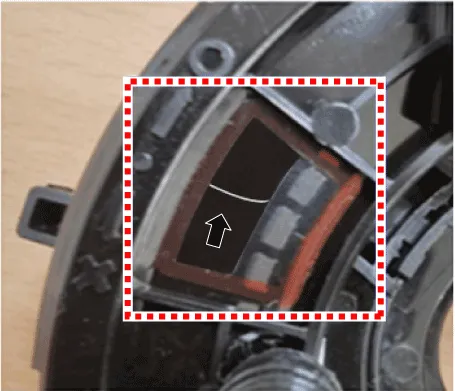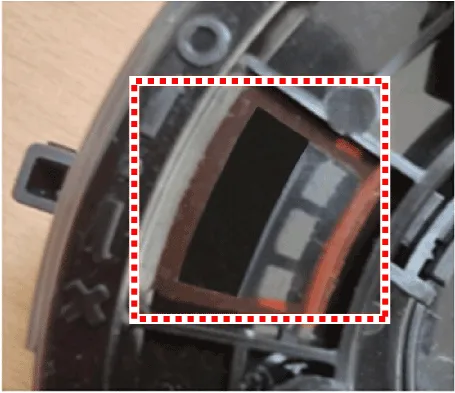Hyundai Accent (HC): Restraint / Airbag Module
Contents:
- Driver Airbag (DAB) Module and Clock Spring
- Passenger Airbag (PAB) Module
- Side Airbag (SAB) Module
- Curtain Airbag (CAB) Module
- Airbag Module Disposal
Driver Airbag (DAB) Module and Clock Spring
• Driver Air Bag (DAB)DAB is installed in the steering wheel, and electrically connected to the SRSCM via clock spring. It is deployed during frontal impact to protect the driver.
• Clock SpringClock spring delivers actuation signal, generated by the sensors installed in the front and right/left sides of a vehicle, to the inflator (gas generator) of the driver air bag module via internal cable.It also delivers actuation signal of the steering wheel remote control switch and horn to relevant systems via internal cable.

• Never attempt to measure the circuit resistance of the airbag module (squib) even if you are using the specified tester. If the circuit resistance is measured with a tester, accidental airbag deployment will result in serious personal injury.
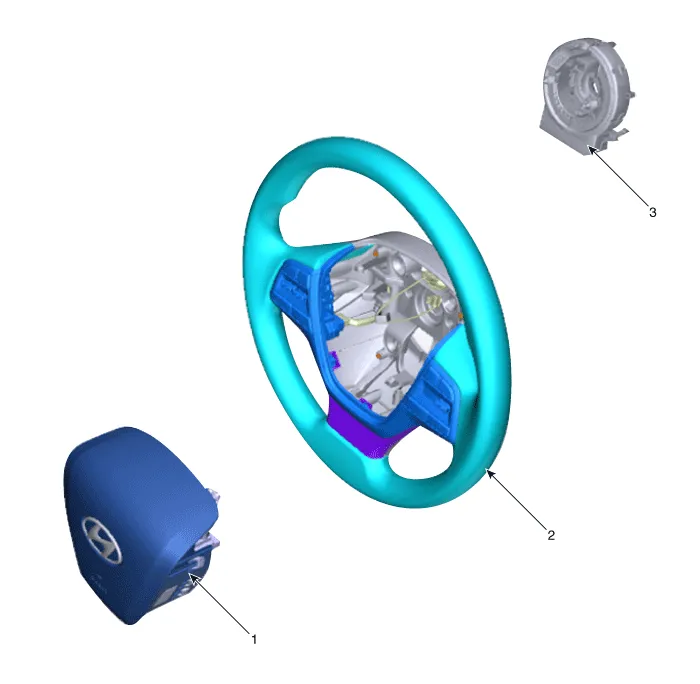
1. Driver Air Bag (DAB)
2. Steering Wheel
3. Clock Spring
1.Disconnect the battery negative cable and wait for at least three minutes before beginning work.
2.Put a flat tool (Ø4mm) into a guide hole located in the bottom of steering wheel and press a spring.
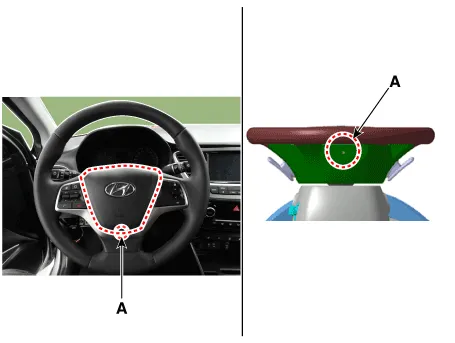


• When put a tool into a hole, make sure not to damage an airbag cusion by a tool.
3.Turn a steering wheel anti-clockwise, so make a guide hole (A) shown on the rightside. Put a tool into a hole (A) and bend back a fixed DAB spring. Make sure to pull DAB cover when bend back the spring.
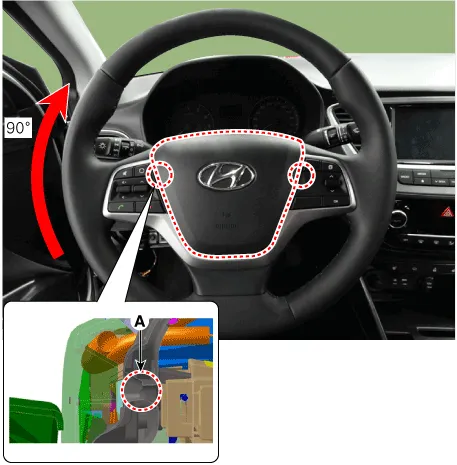

• Pull the DAB cover when disengaging the DAB spring because the DAB does not pop up automatically.
4.Turn a steering wheel clockwise. Put a tool into a hole (B) and bend back a fixed DAB spring. Make sure to pull DAB cover when


• Be careful not to put a tool into a wrong hole.
5.Remove the steering wheel.(Refer to Steering System - "Steering Wheel")
6.Remove the steering wheel and steering wheel column shround(Refer to Steering System - "Steering Column and Shaft")
7.Disconnect the clock spring connector, then remove the clock spring.

• Never attempt to measure the circuit resistance of the airbag module (squib) even if you are using the specified tester. If the circuit resistance is measured with a tester, accidental airbag deployment will result in serious personal injury.
1.Check pad cover for dents, cracks or deformities.
2.Check the airbag module for denting, cracking or deformation.
3.Check hooks and connectors for damage, terminals for deformities, and harness for binds.
4.Check airbag inflator case for dents, cracks or deformities.
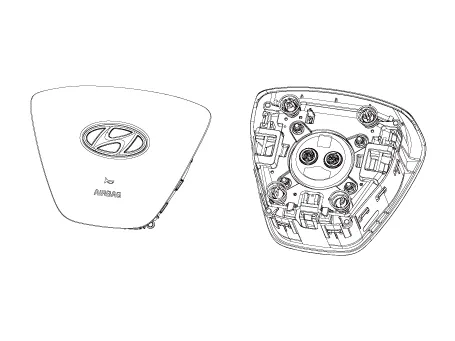
5.Install the airbag module to the steering wheel to check for fit or alignment with the wheel.
1.If, as a result of the following checks, even one abnormal point is discovered, replace the clock spring with a new one.
2.Check connectors and protective tube for damage, and terminals for deformities.
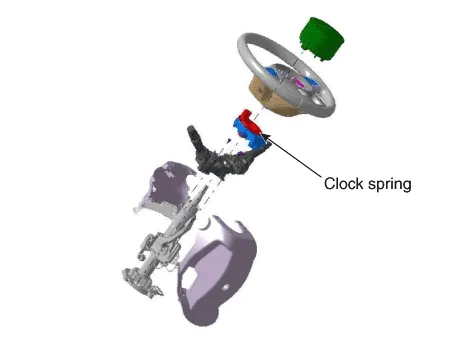

1. Set the front tires straight-ahead.
2. Turn the ignition switch OFF.
3.Disconnect the battery negative cable from the battery and wait for at least three minutes before beginning the work.
4.Connect the clock spring harness connector and horn harness connector to the clock spring.
5.Factory setting for the clock spring is neutral.
1)If white cable is visible through the product's 10 O' Clock Neutral Check Window, then the spring is at neutral.
2)If white cable is not visible through the product's 10 O' Clock Neutral Check Window, then manually adjust the setting to neutral.
| Neutral Check Window : Normal | Neutral Check Window : Fault |
|
|
| White cable is visible through 10 O' Clock Neutral Check Window | White cable is not visible through 10 O' Clock Neutral Check Window |
6.Clock spring manual neutral setting procedure.
(1)Turning the clock spring clockwise untill the stop and then 3 revolution counterclockwise.


• Do not rotate until it stops counterclockwise
(2)If white cable is visible through the 10 O' Clock Neutral Check Window, then the spring is set to neutral.

7.Install the steering wheel column shroud and the steering wheel.(Refer to Steering System - "Steering Column and Shaft")
8.Connect the Driver Airbag (DAB) module connector and horn connector, and then install the Driver Airbag (DAB) module on the steering wheel.

• When install the Driver Airbag (DAB) module, Fix the horn wire and DAB inflator wire tightly with wire clip (A).
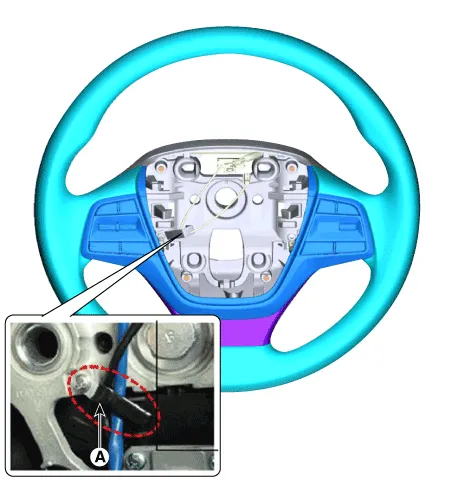
9.Connect the battery negative cable.
10. After installing the airbag, confirm proper system operation :
• Turn the ignition switch ON; the SRS indicator light should be turned on for about six seconds and then go off.
• Make sure horn button works.
Passenger Airbag (PAB) Module

• Never attempt to measure the circuit resistance of the airbag module (squib) even if you are using a specified tester. If the circuit resistance is measured with a tester, accidental airbag deployment will result in serious personal injury.
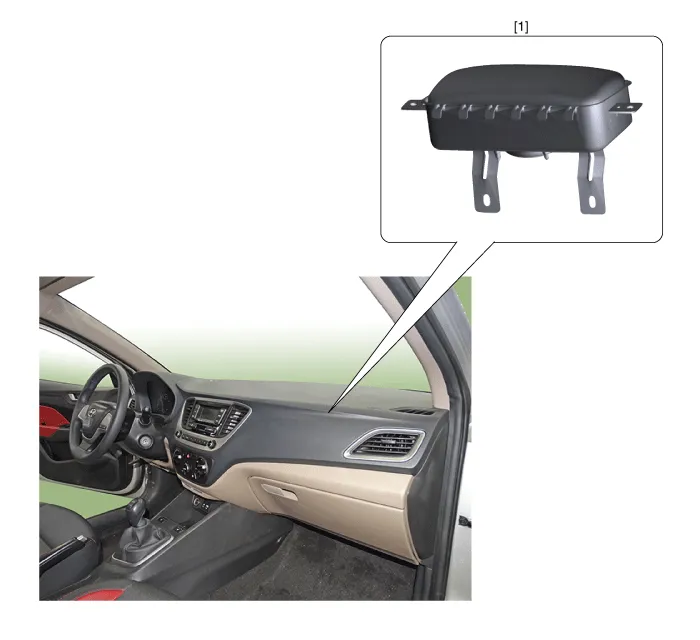
1. Passenger Air Bag (PAB)
1.Disconnect the battery negative cable and wait for at least three minutes before beginning work.
2.Remove the glove box housing.(Refer to Body - "Glove Box Upper Cover Assembly")
3.Disconnect the passenger airbag connector (A) and remove the PAB mounting nuts (B).

4.Remove the crash pad.(Refer to Body - "Main Crash Pad Assembly")

• Replace the crash pad which that has been damaged after the PAB has been deployed.
5.Remove the passenger airbag (A) from the crash pad after loosening the mounting bolts.
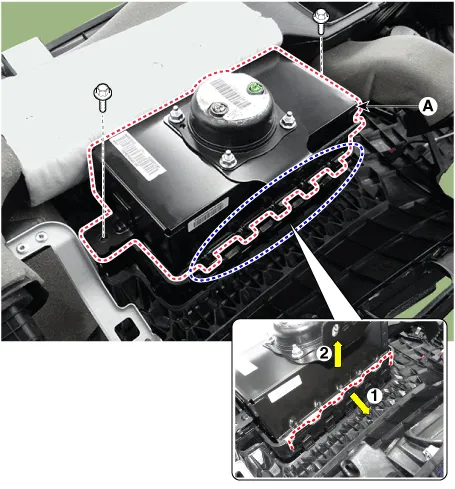

• The removed airbag module should be stored in a clean, dry place with the airbag cushion up.
1.Remove the ignition key from the vehicle.
2.Disconnect the battery negative cable from battery and wait for at least three minutes before beginning work.
3.Place the passenger airbag on the crash pad and tighten the passenger airbag mounting bolts.
Tightening torque :3.9 - 5.9 N.m (0.4 - 0.6 kgf.m, 2.9 - 4.4 lb-ft)
4.Install the crash pad.(Refer to Body - "Main Crash Pad Assembly")
5.Connect the passenger airbag harness connector to the SRS main harness connector.
6.Tighten the passenger airbag crash pad mounting nut.
Tightening torque :3.9 - 5.9 N.m (0.4 - 0.6 kgf.m, 2.9 - 4.4 lb-ft)
7.Install the glove box.(Refer to Body - "Crash Pad Center Panel")
8.Connect the battery negative cable.
9.After installing the passenger airbag (PAB), confirm proper system operation :
• Turn the ignition switch ON; the SRS indicator light should be turned on for about six seconds and then go off.
Side Airbag (SAB) Module

• Never attempt to measure the circuit resistance of the airbag module (squib) even if you are using the specified tester. If the circuit resistance is measured with a tester, accidental airbag deployment will result in serious personal injury.
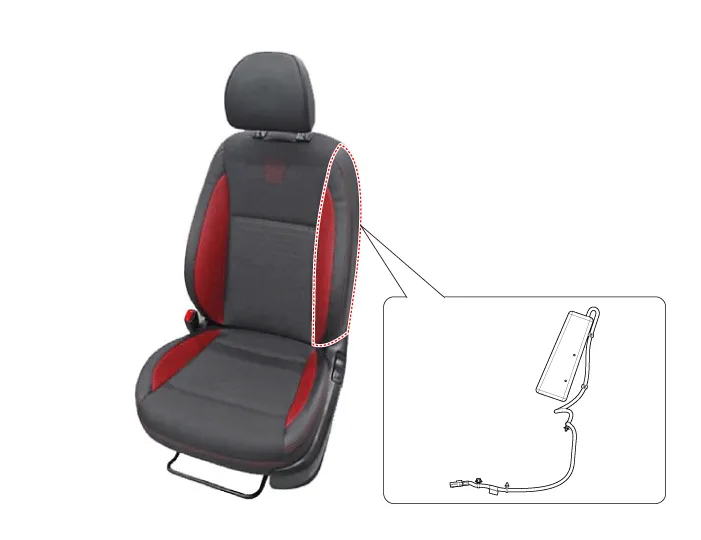

• The side airbag cannot be disassembled from the seat back assembly, so replace assembly when replacing the side airbag.
1.Disconnect the battery negative cable and wait for at least 3 minutes before beginning work.
2.Remove the front seat assembly. (Refer to Front Seat - "Front Seat Assembly")
3.Remove the front seat back cover.(Refer to Body - "Front Seat Back Cover")
4.Remove the side airbag from the seatback after loosening the mounting nut.

• Be sure to install the harness wires not to be pinched or interfered with other parts.

• Do not open the lid of the side airbag cover.
• Make sure that the airbag assembly cover is installed properly. Improper installation may prevent the proper deployment.
1.Remove the ignition key from the vehicle.
2.Disconnect the battery negative cable and wait for at least three minutes.
3.Install the side airbag.
4.Install the front seat back cover.(Refer to Body - "Front Seat Back Cover")
5.Install the front seat assembly. (Refer to Body - "Front Seat Assembly")
6.Recline and slide the front seat forward fully, make sure the harness wires are not pinched of interfering with other parts.
7.Reconnect the battery negative cable.
8.After installing the side airbag (SAB), confirm proper system operation:
• Turn the ignition switch ON; the SRS indicator light should be turned on for about six seconds and then go off.
Curtain Airbag (CAB) Module

• Never attempt to measure the circuit resistance of the airbag module even if you are using the specified tester. If the circuit resistance is measured with a tester, accidental airbag deployment will result in serious personal injury.

1. Curtain Air Bag (CAB)
1.Disconnect the battery negative cable and wait for at least 3 minutes before beginning work.
2.Remove the roof trim.(Refer to Body - "Roof Trim Assembly")
3. Remove the curtain airbag after disconnecting the curtain airbag harness connector and loosening the mounting bolts.
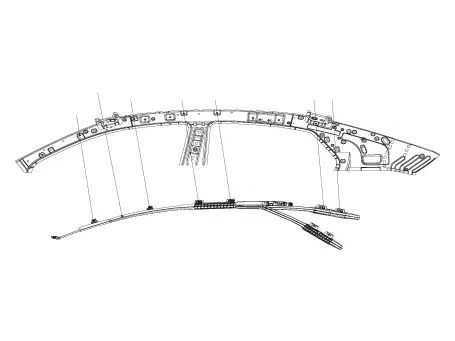
1.Remove the ignition key from the vehicle.
2.Disconnect the battery negative cable and wait for at least three minutes.
3.Tighten the curtain airbag mounting bolts.
Tightening torqueBolt : 7.8 - 11.8 N.m (0.8 - 1.2 kgf.m, 5.8 - 8.7 lb-ft)

• Never twist the airbag module during installation. If the airbag module is twisted, the airbag module may operate abnormally.
4.Connect the curtain airbag connector.
5.Install the roof trim.(Refer to Body - "Roof Trim Assembly")
6.Reconnect the battery negative cable.
7.After installing the curtain airbag (CAB), confirm proper system operation :
• Turn the ignition switch ON; the SRS indicator light should be turned on for about six seconds and then go off.
Airbag Module Disposal

• Upon deployment, the explosion will create a loud noise, so you have to do it in a proper place not to disturb others.
• When you deploy an airbag, use a specially designated tool and select a place where there is no electric noise.
• When operating the airbag deployment tool, you must be at least 5 meters away from the airbag.
• Upon deployment, the airbag gives off an intense heat. So wait for 30 minutes or so before touching it.
• Make sure to use gloves and safety goggles when you deal with the deployed airbag.
• Do not spread water over the deployed airbag.
• Always wash your hands after the deployment work is completed.
1.Turn the ignition switch OFF, and disconnect the battery negative cable and wait at least three minutes.
2.Confirm that each airbag or side airbag is securely mounted.
3.Confirm that the special tool is functioning properly by following the check procedure.
(1)Disconnect the 2P connector between the airbag and wire harness.
(2)Install the SST
• For the driver airbag, separate the 2-pin connector from it and connect the deployment adapter to reattach it on the steering wheel.
4.Locate the airbag deployment tool at a place at least 5 meters away from the airbag.
5.After connecting the deployment adapter with the deployment tool (0957A-34100A), connect it to the external battery for deployment.
(1) Battery (12V)
(2)Deployment tool (0957A-34100A)
(3)Deployment adapter
– DAB, PAB, CAB and BPT (0957A-AL140)
– SAB (0957A-AL150)

6. Switch on the deployment tool to proceed with deployment.
(1)If the battery is connected, the POWER ON (1) light will be on.
(2)Press and hold READY (2) until it is on, and then press DEPLOY (3) to deploy the airbag.
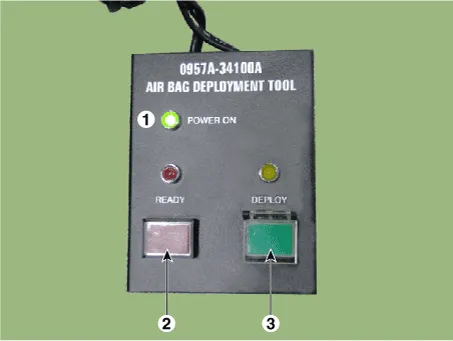

• Upon deployment, the airbag will create a loud noise and you can see it suddenly expand and contract slowly.
7.Dispose of the complete airbag. No parts can be reused. Place it in a sturdy plastic bag and seal it securely.

1.Place the airbag deployment module face upward on a flat surface outdoor.

• If the airbag deployment module were face downward, the airbag will pop up and cause damage to people around it.
2. Get ready to deploy the airbag as follows:
(1)Separate the 2-pin connecter of the airbag from the vehicle.
(2)Connect the deployment adapter.
• For the driver airbag, separate the 2-pin connector from it and connect the deployment adapter to reattach it on the steering wheel.
3.Locate the airbag deployment tool at a place at least 5 meters away from the airbag.
4.After connecting the deployment adapter (0957A-AL140) with the deployment tool (0957A-34100A), connect it to the external battery (12V) for deployment.
(1)Battery (12V)
(2)Airbag Deploy (0957A-34100A)
(3)Deployment adapter
– DAB, PAB, CAB and BPT (0957A-AL140)
– SAB (0957A-AL150)


• When EFD are deployed, broken parts are exploded and scattered.
• EFD (Emergency Fastening Device) must be placed in the piled up 5 tires to avoid exploded broken parts.
• Technicians should wear an eye protector and extremely be cautions of exploded broken parts.
5.Switch on the deployment tool to proceed with deployment.
(1)If the battery is connected, the POWER ON (1) light will be on.
(2)Press and hold READY (2) until it is on, and then press DEPLOY (3) to deploy the airbag.

6.Dispose of the complete airbag. No parts can be reused. Place it in a sturdy plastic bag and seal it securely.

1.Turn the ignition switch OFF, and disconnect the battery negative cable and wait at least three minutes.
2.If installed airbags in a vehicle, follow the removal procedure of damaged airbag.
3.If the removed parts have a lead wire, make a short circuit by twisting together the two airbag inflator wires.
4. Package the airbag in exactly the same packing that the new replacement part come in.
5.Mark the outside of the box ''DAMAGED AIRBAG NOT DEPLOYED'' so it does not get confused with your parts stock.
Other information:
Hyundai Accent (HC) (2017 - 2022) Service Manual: Integrated Thermal Management Module (ITM)
- Components [Intelligent Variable Transmission (IVT) System] 1. Integrated thermal management module (ITM)2 . Integrated thermal management module (ITM) O-ring3. Heater pipe B4. Heater water hose5. Heater pipe A6 . Heater pipe A gasket7 . Water inlet fitting8 . Water inlet fitting gasket [Manual Transaxle System] 1. Integrated thermal management module (ITM)2 .Hyundai Accent (HC) (2017 - 2022) Service Manual: Specifications
- Specifications DescriptionSpecificationsLimit General TypeIn-line, DOHC   Number of cylinders4   Bore75.60 mm (2.9764 in)   Stroke89.0 mm (3.5039 in.)  Total displacement1,598 cc (97.52 cu.in)  Compression ratio11.2 ± 0.2 : 1  Firing order1-3-4-2   Valve timing Intake valveOpensBTDC 42° - ATDC 38°   ClosesABDC 7° - ABDC 87°   Exhaust valveOpensBBDC 43° - ABDC 2°   ClosesATDC 0° - ATDC 45°   Cylinder head Flatness of gasket surfaceLess than 0.
Contents
- Driver Airbag (DAB) Module and Clock Spring
- Passenger Airbag (PAB) Module
- Side Airbag (SAB) Module
- Curtain Airbag (CAB) Module
- Airbag Module Disposal
Categories
- Manuals Home
- Hyundai Accent Owners Manual
- Hyundai Accent Service Manual
- Questions & Answers
- Video Guides
- Useful Resources
- New on site
- Most important about car
- Privacy Policy
0.0072

